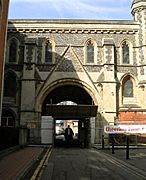Abbey Gateway, Reading facts for kids
Quick facts for kids Abbey Gateway |
|
|---|---|

The gateway as restored in 2018
|
|
| Type | Gateway |
| Location | Reading, Berkshire, UK |
| Owner | Reading Borough Council |
|
Listed Building – Grade I
|
|
| Official name: Abbey Gate | |
| Designated | 22 March 1957 |
| Reference no. | 1155691 |
| Lua error in Module:Location_map at line 420: attempt to index field 'wikibase' (a nil value). | |
The Abbey Gateway is a very old and important building in the town of Reading, Berkshire, UK. It was once the main entrance to Reading Abbey, a huge abbey that is now mostly in ruins. The gateway is one of the few parts of the abbey that are still standing strong today. It's a special building, officially known as a Grade I listed building. This means it's a very important historic site.
Contents
The Abbey Gateway: A Historic Entrance
The Abbey Gateway was originally the inner entrance to Reading Abbey. This abbey was a large and powerful religious building in the center of Reading. The gateway stands next to Reading Crown Court and Forbury Gardens. It has a room for a gatekeeper on the ground floor. Above the gate, there is a large open room.
What Was Its Purpose?
The gateway was a dividing line. It separated the parts of the abbey open to everyone from the areas only monks could enter. The abbot, who was the head of the abbey, lived just inside this gateway. This made the gateway a key meeting spot. It was where the abbot, a very important person in the town, met with the local people.
A Royal Connection
In 1539, a big change happened. This was during the time of the Dissolution of the monasteries. Many abbeys were closed down. Sadly, Hugh Faringdon, the last abbot of Reading, was executed outside the gateway. While other abbey buildings were taken apart for their materials, the abbot's home was saved. It was turned into a royal palace for King Edward VI. His uncle, Edward Seymour, was in charge at the time. The Abbey Gateway was also kept as the entrance to this new royal home.
Queen Elizabeth I often visited this royal palace. However, during the English Civil War, the old abbot's home was damaged. It was never used as a royal palace again. Eventually, the palace was taken down. New houses were built next to the gateway.
Famous Visitors and Schools
In the late 1700s, one of these new houses became the Reading Ladies’ Boarding School. A famous writer, Jane Austen, was one of the students there. The school used the big room above the gateway as a classroom. Imagine having your lessons in such a historic place!
Restorations and Reopening
The gateway needed a lot of repair work after a storm in 1861. Sir George Gilbert Scott, a famous architect, led a big restoration project. In 1900, twelve sculpted heads were added to the gateway. These were made by an artist named Andrew Ohlson.
In 2010, the gateway had to be closed. Some decorative stones fell off, making it unsafe. Fences were put up around it. It reopened in 2018 after a huge restoration project. This work was supported by the Heritage Lottery Fund.
Today, the room above the gateway is used by Reading Museum. They run educational programs for local schools there. The arch below the gateway is open for people walking and cycling. Every year, the Reading Half Marathon race passes right under the gateway. This happens around the 7-mile mark of the race.
Gallery





